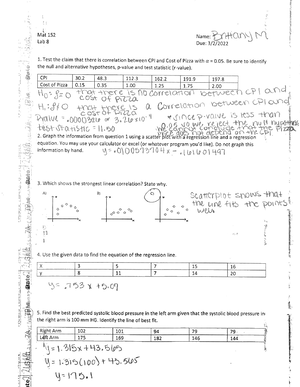According to a Pew Research poll conducted in March 2022
Anonymous Student
Subject:Statistics
AnswerCreated with AI
Hypothesis Testing
In this case, we are testing the claim that the percentage of U.S. parents who would answer "too much time" is 24%. This is a two-tailed test because we are interested in whether the actual percentage is either less than or greater than 24%.
Let's denote:
- p as the claimed population proportion (0.24 in this case)
- p̂ as the sample proportion (133/556 = 0.2392 in this case)
- n as the sample size (556 in this case)
- α as the significance level (0.01 in this case)
Step 1: State the Hypotheses
The null hypothesis (H0) and the alternative hypothesis (H1) are:
- H0: p = 0.24 (The percentage of parents who would answer "too much time" is 24%)
- H1: p ≠ 0.24 (The percentage of parents who would answer "too much time" is not 24%)
Step 2: Calculate the Test Statistic
The test statistic for a proportion is a z-score (z). It's calculated as:
z = (p̂ - p) / sqrt[ p(1 - p) / n ]Step 3: Determine the Critical Value and Rejection Regions
For a two-tailed test with α = 0.01, the critical value for z is approximately ±2.58. This means the rejection regions are z < -2.58 and z > 2.58.
Step 4: Make a Decision
If the calculated z-score falls within the rejection region, we reject the null hypothesis. If it does not, we fail to reject the null hypothesis.
Step 5: Interpret the Result
If we reject the null hypothesis, it suggests that the percentage of U.S. parents who would answer "too much time" is not 24%. If we fail to reject the null hypothesis, it suggests that the data does not provide strong evidence against the claim that the percentage is 24%.
Remember, failing to reject the null hypothesis does not prove it is true. It simply suggests that the data does not provide strong evidence against it.
Relevant documents
Documents that match the answer
- Discover more from:
Related Answered Questions
- Statistical Methods I (MAT 152)According to a Pew Research poll conducted in March 2022, 61% of U.S. adults say abortion should be legal in all or most cases. They used a random sample of n=10,441 people where 6369 said that abortion should be legal in all or most cases. Test the claim that more than 61% of U.S. adults believe that abortion should be legal in all or most cases, using a 0.05 significance level.Answers
- Statistical Methods I (MAT 152)Our hypothesis is that female super models have a height greater than the mean heights of women in general. The mean of the general population is 62.3 inches (5.2 ft). We sample 12 super models and get a mean of 69.6 inches (5.8 ft). Given a sample standard deviation of 2.4 (that means σ is unknown) and will use an alpha α of 0.01. Find the p value.Answers
- Statistical Methods I (MAT 152)If 1080 of 2000 people sampled dressed up for Halloween and I want to construct a 90% CI.... Use the calculator procedure shown in class or look back on the PP slide to calculate the Confidence Interval.Answers
- Statistical Methods I (MAT 152)Given Confidence Interval of (1, 7), calculate the MOE?Answers
- Statistical Methods I (MAT 152)Given a Confidence Interval of (1,7), what is x bar (mean)?Answers
- Statistical Methods I (MAT 152)
A population of values has a normal distribution with u=163.1 and o=67.1 . You intend to draw a random sample of size n=176 . Find the probability that a single randomly selected value is between 174.7 and 176.3. P(174.7 < X < 176.3) = Find the probability that a sample of size n=176 is randomly selected with a mean between 174.7 and 176.3. P(174.7 < M < 176.3) = Enter your answers as numbers accurate to 4 decimal places. Answers obtained using exact z-scores or z-scores rounded to 3 decimal places are accepted.
Answers



